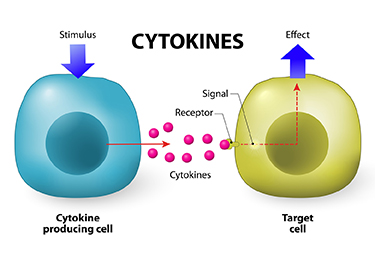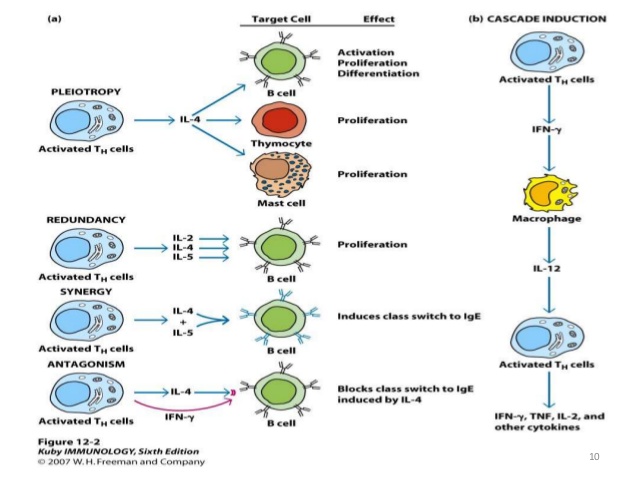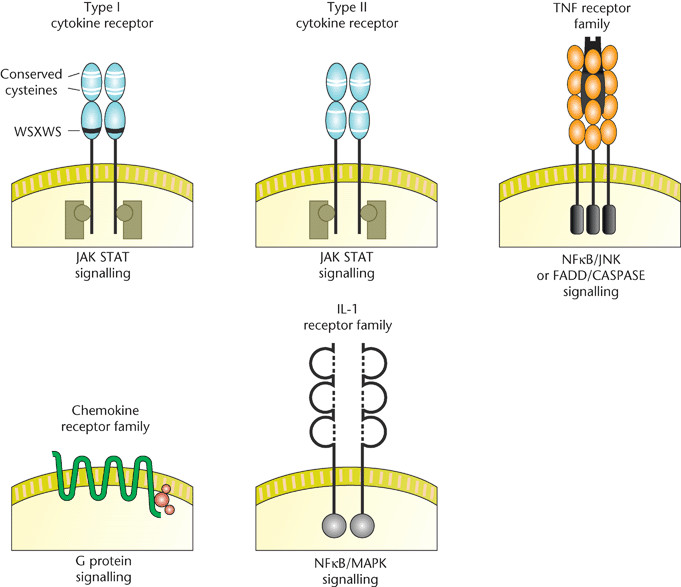
Cytokines: properties and receptors
- Cytokines are low molecular weight (30KDa) regulatory protein or glycoprotein secreted by White blood cells and various other cells in body in response to number of stimuli. These regulatory proteins help in regulating the development of immune effector cells and some cytokines also have their own functions.
- Many cytokines are refered as interlukins; the name indicates that they are secreted by leucocytes and acts upon other leucocytes. Interlukins are designed from IL-1 to IL-29 and it is supposed that additional cytokines will be discovered and the group Interlukins will expand further.
- Some cytokines are known by their common name. for examples; tumor necrosis factor, Interferon etc.
Properties of cytokines:
1. Target Specific and induce signal transduction:
- cytokines binds to specific receptor on the cell membrane of target cell which triggers signal transduction pathway that ultimately alter gene expression in target cell.
2. High affinity:
- The affinity between cytokines ad their receptor is very high. Because of high affinity, cytokines can mediate biological effects at picomolar concentration.
3. Action:
- a particular cytokine possess one of the following action:
- i) Autocrine action: the cytokine may binds with the membrane receptor of same cell that secrete it.
- ii ) Paracrine action: the cytokine may bind to the receptor on a target cell in close proximity to producer cell.
- iii) Endocrine action: cytokine may binds to the target cell in distant part of the body.
4. Attributes:

- cytokines exhibit induction of following attributes:
- i ) Pleiotropy: a given cytokine has different biological effects on different target cell.
- ii) Redundancy: two or more cytokines that mediate similar function.
- iii) Synergy: combined effect of two cytokine on cellular activity is greater than effect of individual cytokine.
- iv) Antagonism: the effect of one cytokine inhibit the effect of another cytokine.
- v) Cascade: when the action of one cytokine on a target cell induce that cell to produce one or more other cytokines, which in turn induce other cell to produce cytokines.
5. Biological functions of cytokines:
- Stimulate development of cellular and humeral immune response
- Induction of inflammatory response
- Regulation of hematopoiesis
- Control of cellular proliferation and differentiation
- Healing of wounds
Cytokines family:
- Hematopoietin family
- Chemokines family
- Interferon family
- Tumor necrosis factor (TNF) family
- Colony stimulating factor (CSF) family
Cytokine receptor family:
Cytokines exert their biological function by binding with specific receptor on membrane of target cell. Many types of target cell expresses receptor and are susceptible to cytokine binding.
Cytokine receptor belongs to one of the following family.
1. Type-I cytokine receptor family; Hematopoietin receptor family:
- Majority of cytokine receptor belongs to this class. These receptors have certain conserved motifs in their extracellular amino-acid domain, and lack an intrinsic protein tyrosine kinase activity
- This family includes receptors for IL2 (beta-subunit), IL3, IL4, IL5, IL6, IL7, IL9, IL11, IL12, GM-CSF, G-CSF, Epo, LIF, CNTF, and also the receptors for Thrombopoietin (TPO), Prolactin, and Growth hormone.
- Type I cytokine receptor family is subdivided into three subsets on the basis of the ability of family members to form complexes with one of three different types of receptor signaling components (gp130, common beta, and common gamma – the gamma-chain of the IL2 receptor).
2. Type-II cytokine receptor family; Interferon receptor family:
- There are multimeric receptors composed of heterologous subunits, and are receptors mainly for interferons.
- This family includes receptors for IFN-alpha, IFN-beta, IFN-gamma, IL10, IL22, and tissue factor.
3. Tumor necrosis factor (TNFR) family:
- These receptor family share a cysteine-rich domain (CRD) formed of three disulfide bonds surrounding a core motif of CXXCXXC creating an elongated molecule.
- TNFR is associated with pro-caspases through adapter proteins (FADD, TRADD, etc.) that can cleave other inactive pro-caspases and trigger the caspase cascade, irreversibly committing the cell to apoptosis.
4. Chemokine receptor family:
- These receptors are G protein-coupled receptors with 7 transmembrane structure and couple to G-protein for signal transduction.
- Chemokine receptors are divided into different families: CC chemokine receptors, CXC chemokine receptors, CX3C chemokine receptors, and XC chemokine receptor (XCR1).
5. Immunoglobulin super family receptor:
- There induce receptors for IL-1, M-CSF, c-Kit, IL-18. It plays role in inflammation.
6. TGF-beta receptor family:
- These are single pass serine/threonine kinase receptors.
- TGF-beta receptors include TGFBR1, TGFBR2, and TGFBR3 which can be distinguished by their structural and functional properties.

